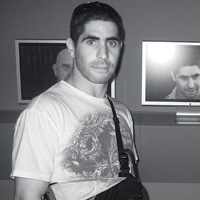It was only a matter of time before a Chinese artist modelled a catalogue on Mao’s Little Red Book. To her credit, the artist O Zhang’s version, The World is Yours (But Also Ours), feels less like a gimmick than a quotation, an allusion that chimes resonantly with her subject matter. For some time now, O, who divides her time between New York and Beijing, has been chronicling what she calls China’s second Great Leap Forward, its 21st century economic rise and internationalisation. A series of conceptual photographs, The World is Yours (But Also Ours) examines China through the lens of black humour.

Taken during the two months prior to the Beijing Olympics, colour images of individual Chinese youths are coupled slogans in Chinese. As she writes in the catalogue introduction, “The text follows the form used in Cultural Revolution era propaganda posters: an image bordered with a slogan in bold text below it.” The slogans themselves might come from Mao but also from advertising and other sources. In the pictures, each of the kids happens to wear a T-shirt with phrases in Chinglish: English that has been mistranslated, either linguistically or culturally. A perfect example of the latter: a work juxtaposing the slogan Poverty is not Socialism – a formulation uttered by former leader Deng Xiaoping in a 1984 speech announcing a new policy of reform and ‘opening up’ of China to the rest of the world – and a photo of a girl wearing a multi-coloured T-shirt bouncily proclaiming Everything is Shit. Among the image’s many ironies is the fact that Deng’s policy literally produced the T-shirt, which, one assumes, neither the pre-pubescent girl nor her parents would assent to, if they understood its meaning.

Indeed, the cultural mistranslations tend to be the most poignant, and O’s images demonstrate that such mistranslations come in many forms. China, Add Gasoline reads one Chinese text: it’s a popular cheer in sporting events, akin to Step on the Gas. Above it, a girl with a car-shaped handbag on her shoulder raises an arm to a sky crisscrossed with the enormous cranes that have become an ordinary feature of life in large Chinese cities. The topsy-turvy associations of the cheer – notably the drastic environmental consequences of the country’s high-octane economy – are, in a sense, paralleled by the jumbled text on the girls shirt, which reads Love Haney Me &. Less common, though not absent, are overtly political works. Salute to the Patriot depicts a girl before the Tiananmen Gate Tower, a large Mao poster over her shoulder, who wears a T-shirt that assures us It’s all Good in the Hood, a phrase from American Black culture.

Misspelled names of brands such as Adidas or, as the T-shirt in Enhance National Confidence has it, PMUN (for Puma) worn by a girl flashing a peace (or victory) sign, take us from parodies of ghetto culture into the black market, where China’s underground economy thrives by churning items like fake Puma sneakers and T-shirts. The black market is a part of the political reality that is the true subject of these pictures, but which they never address directly. So Faster, Higher, Stronger (the motto of the Olympics) presents a shades-wearing girl in a T-shirt with a sort of nonsense version of a Brillo box on it, which of course recalls Andy Warhol’s Brillo boxes. Warhol’s innovation was to make a simulacrum of the Brillo boxes a real work of art, while O Zhang makes art out of images of real fakery.

The black humour of real fakery explains why all the kids in the series are shot from below: They’re cast in a heroic or mock-heroic light, depending on how one chooses to look at them. Consider the work that gives the show its title. A tired-seeming girl looks down at the camera; she wears a T-shirt that reads, in part, ‘throw your hands up China’, a reference, perhaps inadvertent, to a hip-hop line, ‘throw your hands in the air’. Behind her stands a statue of Mao with his hand raised skyward in salute. The series title come from a well-known speech by Mao, which continues; “You young people, full of vigour and vitality, are in the bloom of life . . . Our hope is placed on you.” The young are the heroes of China’s future, its hope, and the world is theirs. But it is also ‘ours,’ meaning Mao’s and the Communist Party’s, those who would mock and destroy the freedoms those kids now seek.













